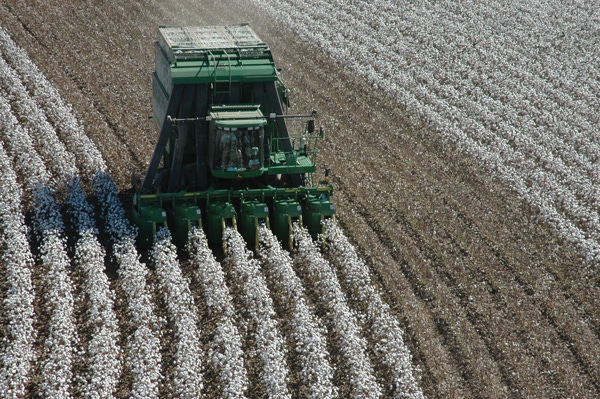
Round and rectangular cotton bales are stacking up at cotton gins in the Rio Grande Valley this week as cotton harvest has reached the half-way mark in Deep South Texas. In the Coastal Bend, many growers are plowing up heat-stressed cotton fields and preparing crop insurance forms as a result of heat and a lack of substantial rainfall.
Also of concern is cotton in the Mid and Upper Coast regions where heavy rains in July set harvest schedules back and is causing numerous problems related to exceptionally wet fields, including pest pressure.
John Norman, editor of the Valley’s Pest Cast Newsletter, is reporting cotton in South Texas is either being harvested or reaching final maturity. Most cotton fields are defoliated while others will require at least two more weeks before harvest can begin.
“Whiteflies were unrelenting in their migration last week. Fields which had been sprayed for whiteflies as late as July 13 were, in some situations, covered with adults and immatures this week. However, there were a few late maturing fields in which there were few whiteflies even at this late date,” Norman reported July 27.
He says plans for managing immature fields well into August must include whitefly management.
Heavy concentrations of whiteflies are reported in fields along the Rio Grande River and in many irrigated fields. He says growers in those areas report increased production costs associated with whitefly control and management in recent weeks.
“Unlike years like 1991 when the Valley first experienced whiteflies at damaging levels by mid-May in a triangle from San Benito in Cameron County to west of Mission in Hidalgo County and all the way north to Raymondville in Willacy County, the Valley’s experience this year was limited in both area and time of severely damaging whitefly numbers,” he added.
But late maturing fields will take the brunt of large numbers of pests such as whiteflies, which can be devastating to late cotton he says. No other pests at harmful numbers were reported in fields last week.
Preliminary cotton yields in dryland fields were reported from just under a bale to nearly two bales per acre. There were still large numbers of dryland fields to be picked, but early yields looked pretty good ranging from near two bales to 3.25 bales per acre.
Coastal Bend Cotton
In the Coastal Bend, dry, hot weather dampened prospects of a successful cotton year. Nueces County Extension Agent Jeffrey Stapper is reporting a “disappointing year” for cotton in the Coastal Bend as a result of negative drought impact.
“Yields this year were such that many producers are having their crop adjusted out by Crop Insurance as economics indicated that it was more economical to collect insurance on the adjusted crop yield and destroy the remaining crop rather than harvest the poor crop,” Stapper reported.
Mid-Coast/Upper-Coast Cotton
Tropical rainfall in parts of southeastern Texas in July dropped as much as 16-inches of rain on many fields, hampering corn, grain sorghum and cotton fields with seed sprouting with some minor lodging reported in corn.
Texas AgriLife Extension Agent-IPM Clyde Crumley is reporting the balance of cotton is at physiological cutout, so the next hurdle for cotton will be protecting the bolls from insect damage. In addition, he adds, now is the time to be considering harvest aids.
“Cutout is an important physiological landmark in that it helps us determine when a cotton crop is ‘safe’ from economic insect damage and in evaluating yield potential as well as when to apply harvest aids. Now, it appears that our cotton crop is a few days ahead of normal when it comes to average heat units for this year, and you should consider that when thinking about preparing for harvest,” Crumley writes in his weekly Upper Coast Crop Improvement Newsletter.
With substantial rains and a delayed harvest, Crumley says growers should be scouting for insect pressure.
“Regarding insects, research has shown that small bollworms will not feed on bolls that are more than 350 heat units (HU) past bloom, stink bugs will not feed on bolls past 450 HU, Lygus 350 HU and for verde plant bugs (VPB) we are not 100 percent sure, but our best guess would be it is similar to Lygus. With all that said, we are continuing to monitor for bollworms, fall armyworms, stink bugs, spider mites, aphids, Lygus and VPB,” he writes.
Of particular concern in cotton right now are stink bugs. In the Upper Coast region, brown stink bug seems to be the predominant type, but Crumley warns to monitor for green stink bugs as well.
“I think it would be appropriate to prepare for stink bug treatment and not wait another week when 15 percent evidence of internal feeding is found. Stink bugs are often clumped near field margins. Spot treatment provides effective control when this situation exists,” he adds.
About the Author(s)
You May Also Like




